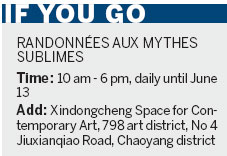
|
|
A Peruvian-born French citizen living in China, artist Martin Salazaar, has tapped into his multicultural background and merged the themes of real life and mythology to produce his latest collection of art. Salazaar's exhibition at the Xindongcheng Space for Contemporary Art, Randonnees aux mythes sublimes, opened last Saturday and displays, for the first time in public, six of his most recent works.
"I wanted to take mythology and match it with day-to-day life, to match eternity and today," he said.
Salazaar, who obtained a master's degree from the Central Academy of Fine Arts in Beijing in 1998, has spent the past 10 years living in both China and France, an experience that is reflected in his latest show.
Entering the exhibition hall, visitors are confronted with a dark room in which a camphor-wood carved woman sits before a projector screen with a blank facial expression. Projected behind her are scenes of people waiting in line for the Paris metro.
Entitled Metro, Salazaar said the idea behind the piece was to somehow incorporate his experiences living in Paris with his experiences living in China, bridging the gap between the two.
"China is opening its doors to many new things but the artistic community is still quite closed to outside influences," he said. "By displaying my art here, I am trying to, hopefully, open doors like doors were opened to me elsewhere."
 He said the most important element of Metro is the emotionless facial expression of the woman sitting in the chair before the projector screen. Fashioned after the expressions often found in the art of the Tang Dynasty, Salazaar said it was his way of showing how Chinese art has had an influence on him.
He said the most important element of Metro is the emotionless facial expression of the woman sitting in the chair before the projector screen. Fashioned after the expressions often found in the art of the Tang Dynasty, Salazaar said it was his way of showing how Chinese art has had an influence on him.
Though the first room in the exhibition may have the least amount of light, the darkest piece of the collection is easily Jingshun Rd 22:30.
Aimed at interpreting the everyday monotony of the life of migrant workers, especially those in Beijing, the work is set up in a dark corner of Xindongcheng's massive exhibition hall.
At the center of the piece are seven steel-faced wooden totems carved to look like Chinese migrant workers. Made using antique wooden support beams collected from demolished Beijing houses, the totems sit before a wall painted to look dirty. In the middle of the work, a black and white video of a man chipping stone plays, offering a repetitive clinking noise with each strike of his hammer.
Salazaar said the piece was inspired, while crossing Jingshun road, by a group of migrant workers he spotted watching TV.
What makes this show particularly special is that it is his first exhibition that incorporates the use of multimedia into his installations.
"I wanted to explore a new realm, an area I hadn't done before," he said. "There was no detail that was left unconsidered."
Other works in the collection include a brightly colored, almost cartoon-like portrayal of Adam and Eve and, more on the theme of mythology, a camphor-wood carved Minotaur, a mythical creature that is a combination of both man and bull.
|
|
|
|
|
|